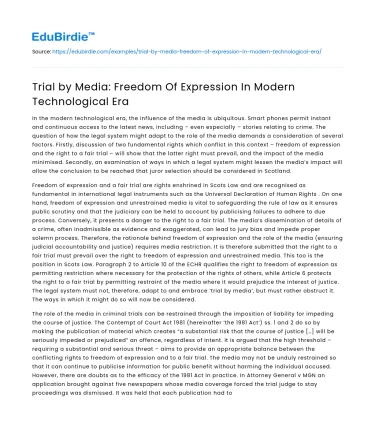In the modern technological era, the influence of the media is ubiquitous. Smart phones permit instant and continuous access to the latest news, including – even especially – stories relating to crime. The question of how the legal system might adapt to the role of the media demands a consideration of several factors. Firstly, discussion of two fundamental rights which conflict in this context – freedom of expression and the right to a fair trial – will show that the latter right must prevail, and the impact of the media minimised. Secondly, an examination of ways in which a legal system might lessen the media’s impact will allow the conclusion to be reached that juror selection should be considered in Scotland.
Freedom of expression and a fair trial are rights enshrined in Scots Law and are recognised as fundamental in international legal instruments such as the Universal Declaration of Human Rights . On one hand, freedom of expression and unrestrained media is vital to safeguarding the rule of law as it ensures public scrutiny and that the judiciary can be held to account by publicising failures to adhere to due process. Conversely, it presents a danger to the right to a fair trial. The media’s dissemination of details of a crime, often inadmissible as evidence and exaggerated, can lead to jury bias and impede proper solemn process. Therefore, the rationale behind freedom of expression and the role of the media (ensuring judicial accountability and justice) requires media restriction. It is therefore submitted that the right to a fair trial must prevail over the right to freedom of expression and unrestrained media. This too is the position in Scots Law. Paragraph 2 to Article 10 of the ECHR qualifies the right to freedom of expression as permitting restriction where necessary for the protection of the rights of others, while Article 6 protects the right to a fair trial by permitting restraint of the media where it would prejudice the interest of justice. The legal system must not, therefore, adapt to and embrace ‘trial by media’, but must rather obstruct it. The ways in which it might do so will now be considered.
Save your time!
We can take care of your essay
- Proper editing and formatting
- Free revision, title page, and bibliography
- Flexible prices and money-back guarantee
The role of the media in criminal trials can be restrained through the imposition of liability for impeding the course of justice. The Contempt of Court Act 1981 (hereinafter ‘the 1981 Act’) ss. 1 and 2 do so by making the publication of material which creates “a substantial risk that the course of justice […] will be seriously impeded or prejudiced” an offence, regardless of intent. It is argued that the high threshold – requiring a substantial and serious threat – aims to provide an appropriate balance between the conflicting rights to freedom of expression and to a fair trial. The media may not be unduly restrained so that it can continue to publicise information for public benefit without harming the individual accused. However, there are doubts as to the efficacy of the 1981 Act in practice. In Attorney General v MGN an application brought against five newspapers whose media coverage forced the trial judge to stay proceedings was dismissed. It was held that each publication had to be considered independently. In this sense, the 1981 Act has been criticised for failing to account for the cumulative effect of media coverage. With the press now able to reach potential jurors through social media and smart phones, and the widespread dissemination of information facilitated by technology, the collective impact of the media should not be ignored.
Given the difficulty in controlling media coverage in the modern world, perhaps more attention should be given to the possibility of jury instructions and selection in obstructing ‘trial by media’. Jurors in Scotland are given directions, including to disregard inadmissible evidence, such as that which may already have been publicised in media coverage. However, psychological studies suggest that such instructions are ineffective . Jurors cannot unhear what is already heard, so to speak, and bias persists to the detriment of a fair trial. A further measure to eliminate juror bias which can be created by pre-trial publicity is therefore required. Juror selection is a possibility. In Scotland, jurors are chosen at random from the electoral register. In other jurisdictions, notably in US federal juries , potential jurors are questioned by voir dire and excused before trial on suspicion of bias. Judges examine potential members, and both prosecution and defence can strike members to ensure a balance of mentality for the jury.
The individual accused’s right to a fair trial prevails in Scots Law over the right to freedom of expression. With rapid advancements in technology, it is increasingly difficult to restrain media coverage. The 1981 Act does not go far enough in holding the press in contempt of court as it fails to consider the cumulative impact of publications and the omnipresence of the media in modern times. Measures which can limit the impact of media coverage on jurors, to eliminate bias and ensure a fair trial, are therefore essential. Juror directions to disregard inadmissible evidence which may already have been presented by the press are arguably ineffective. It is concluded, therefore, that juror selection in Scotland by voir dire should be seriously considered by policy makers as reducing bias and minimising the effects of pre-trial publicity – thereby preventing adaptation to ‘trial by media’.






 Stuck on your essay?
Stuck on your essay?

